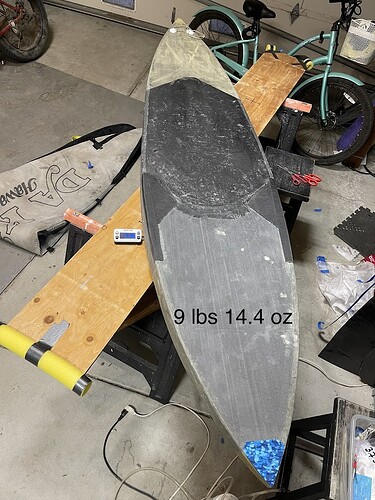Objective to make a Sub 10 lbs Downwind SUP Foil board!
Final Weight 9 lbs 12 oz or 4.4 KG: 7’ 9" x 21" 6" @ 128 Liters
My design was constrained as follows:
• XPS Waterproof foam with Density 1.5 lbs per foot cubed.
• Board designs are changing so fast you might pay $1,500 or more and get a board that is obsolete in 6 months
• Figure out how to minimize the investment in ‘Unnecessary’ infrastructure. This includes:
- Material 2) Cost and 3) Weight
• The board does NOT have to last 10 years
• 100% Vacuum Bagged at every Step: Full 20+ in HG. The XPS foam that can handle 25 psi, eg. full vacuum pressure, resulting in better and tighter final laminations.
• Invest in the Foot area and the TRACKS. BUT Don’t over index on the TRACK reinforcement. I have been a Tuttle advocate since Day 1. For 30+ years Tuttles were the only boxes that wouldn’t rip out of windsurfers. Tuttles go Deck-to-Deck. There has to be some substantial material extending from Deck to Deck. BUT there could be a very light Matrix of foam and carbon rod, with solid top and bottom carbon layer for example that would suitably hold the load for dual tracks.
Additional thoughts: XPS is closed cell foam. It will NOT absorb water. It weighs 1.5 lbs per cubic foot. EPS is lighter but when you get a ding it will absorb water quickly.
There have been several prototype boards in the neighborhood made with XPS. One board did NOT even cover all the XPS but left exposed foam in Non-Critical areas. After 2 years the foam, with little care, started to flake off from chips and/or dings.
I have been testing another approach that would be to GORILLA glue the DRY fiber to the XPS. The objective would be to provide a lightweight jacket to the foam. It would carry load in TENSION only, leaving the fiber attached to the foam but NOT fully wetted out.
IT IS POSSIBLE THAT GORILLA GLUE IS SUPERIOR TO EPOXY AT BOTH ADHERING TO FOAM SUBSTRATES AND HOLDING FIBER IN PLACE FOR TENSILE LOADS. The only hesitation is Gorilla Glue’s ability to handle compress ive loads as part of a Composite Matrix.
Advantages:
-
Ding Prevention. The exposed XPS dings with a fingernail. A test piece of foam with carbon was very durable. Another test piece with 3.7 oz S-Glass fiber worked very well and was resistant to puncture, even good with a hammer test, but lighter than the carbon sample.
-
Compressive loads would have to be carried by the XPS foam. But the shell of fiber would still be stiffer and more resilient than foam alone
-
The skin material is porous. Some people have experienced delamination related to XPS foam. Because the foam is closed cell ANY moisture that is trapped between the foam and an impermeable skin is at risk of evaporation and delamination. IF the fiber is porous this would significantly reduce the risk of delamination. PS: After building I suspect many delaminations were from either A) Overheating in the Sun or B) NOT using a vacuum to laminate the Board





